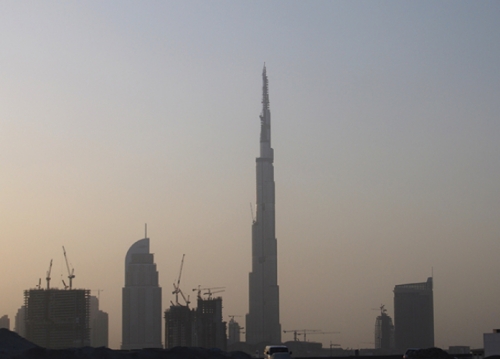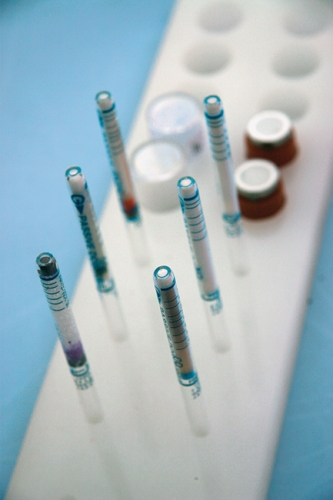The chefs brought out a roasted baby camel on a silver platter, and Jacqueline MacDonald took her seat. A few of her colleagues were in the banquet hall with her, and so were a few of their competitors. His Excellency Majid Al Mansouri, Secretary General of the Environment Agency-Abu Dhabi, had invited everyone.
“In the United States, when you apply for a research grant, you’re not usually invited to a dinner with your competitors,” MacDonald says. Months earlier, the World Health Organization and the Environment Agency-Abu Dhabi had called for proposals from universities around the world to help the United Arab Emirates develop a plan for the country’s environmental health. Researchers from all three finalists — Carolina, Harvard, and Johns Hopkins — were at dinner that night. It was a little tense, MacDonald says.
But two months later in March 2008, MacDonald, an environmental engineer and principal investigator on UNC’s proposal, got word that Carolina had beaten out the competition. The UAE wanted to get started quickly. Within one year, officials said, they would figure out which environmental problems posed the greatest danger to public health and come up with a strategy to solve those problems in a decade’s time. (Things have been happening fast in the UAE ever since oil moguls discovered that Abu Dhabi, the largest of the seven emirates, sits on top of 8 percent of the world’s remaining petroleum reserves.)
MacDonald and the team at Carolina found that a population explosion, a real-estate boom, and whirlwind industrialization have brought air quality and occupational risks to the top of the list of the UAE’s environmental troubles. At UNC, teams of epidemiologists and environmental scientists are taking a close look at pollution in the UAE, including both outdoor and indoor air pollution. And in a related study, nutritionist Barry Popkin is examining the changing Emirati diet and working on a solution to the UAE’s skyrocketing rates of diabetes and obesity (see “New diet, new dangers.”).
In less than forty years, the UAE has evolved from a country of Bedouin nomads and fishermen to the title-holder of several global superlatives. It’s home to the tallest man-made structure on Earth (the Burj Dubai is almost double the height of the Sears Tower). It has one of the world’s biggest shopping malls, two of the world’s four seven-star hotels, and the largest desalination plant. And, according to Popkin, one of the highest rates of diabetes in the world.
“The country has developed at lightning-quick pace,” MacDonald says, “and it’s a little frightening for some people.” Where, not long ago, the empty desert stretched all the way to the sea, the ultra-modern coastal cities of Abu Dhabi and Dubai are filled with thousands of luxury cars and SUVs and, above those, cranes and construction workers that toil over the UAE’s $582 billion in building projects. Of course, construction has slowed down lately with the world’s economy (although only slightly in Abu Dhabi), but a lot of the environmental damage has already been done, MacDonald says. A haze often hangs over the cities. Toxicants have even begun to cling to particles of desert sand, and the wind flings them across the entire Middle East region.
Airborne dust is one of the main dangers of outdoor air in the UAE, says environmental scientist William Vizuete, whose team is now beginning to test an air-quality model it created for the region. “Sandstorms and dust events in the UAE are huge, and they happen frequently,” he says. The UAE lies near the equator and on the crossroads of long-range dust plumes from Europe and Central Africa. The sun’s irradiative energy combines with aerosols to create some interesting photochemistry, Vizuete says. The conditions are nothing like what we see in the United States or other Western countries, where models of the kind Vizuete is working on are standard.
Once the model is complete and tested, he and his team will be closer to understanding just how all the particulate matter in the UAE affects human health. “Say you have a dust particle that goes across the Arabian Peninsula and then enters Dubai,” Vizuete says. “You have all these man-made chemicals, and maybe there’s some partitioning of those toxic organics onto the particle. And then you breathe in that dust particle. What does that mean for public health?”
Air monitors in Abu Dhabi have already shown high levels of PM10 — airborne dust particles that have a diameter of up to ten micrometers. But scientists want to know what percentage of that is actually PM2.5, much smaller particles that could be more damaging to human health. And how much of the PM10 in UAE comes from desert sand rather than, say, gasoline combustion, construction, or quarrying? Vizuete and his team are working with the Environmental Agency-Abu Dhabi to gather more air-quality data, test their model, and, they hope, answer some of these questions.
Most Emiratis, though, don’t actually spend a whole lot of time outdoors, MacDonald says. The environment is harsh — temperatures during the summer months can climb above 120˚F, and the coastal humidity is high. Many Emiratis spend their days in air conditioned houses, office buildings, and shopping malls. So UNC epidemiologists are studying the air quality inside six hundred homes in the UAE to find out if Emirati families are exposed to pollutants there.
“This is a country with a lot of new housing,” says epidemiologist Karin Yeatts, who’s helping to lead the indoor air study. Walls, furniture, and carpets in new buildings can emit formaldehyde and other gaseous pollutants that can aggravate respiratory problems. Pollutants from outside — including nitrogen dioxide, carbon monoxide, and particulate matter — could make their way into the homes, Yeatts says, and the researchers will take measurements of all of them. For the sake of cooling efficiency, most air conditioning units in the UAE are positioned high in the walls or in other difficult-to-reach spots. So changing the filters isn’t easy, she says, and families could be exposed to bacteria or different types of mold from the AC units.
Yeatts and her team are collecting data on indoor air, health, and nutrition from six hundred homes in the UAE as part of a vast epidemiological study on the potential health effects of the air pollutants. So researchers equipped each of the homes with a handful of passive diffusion tubes, slim vials of a spongy material that change color to indicate the concentrations of different gas compounds in the air. In the United States, the tubes typically are used to measure high concentrations of industrial compounds at work sites or in schools over eight-hour periods, but UNC researchers will use them to measure low concentrations over the course of a week. No one’s done this before, says environmental scientist David Leith. “It’s all easy-to-use technology that doesn’t require expensive equipment,” he says. “You don’t have to send the things off to be analyzed and wait two months. You just look at the color, divide by the number of hours, and that tells you how bad the exposure is. You get the result right away.”
Each house will also get a passive aerosol sampler, a small metal disk that Leith invented with doctoral student Jeff Wagner. It’s the size of a bottle cap and, like the passive diffusion tubes, doesn’t require electricity. Particles floating in the air come to rest on the disk throughout the day, and researchers then use a scanning electron microscope to see what settled there. Some of the houses will also have active monitors (which do require electricity) that will pump out real-time measurements of whichever compounds are in the air.
No one’s ever conducted a nationwide study like the UAE project in the United States, MacDonald says. U.S. environmental policy, as in most developed countries, has evolved in reaction to disasters, and only then if there’s money to make the changes. (Take water pollution, she says. It wasn’t until Cleveland’s Cuyahoga River caught fire in 1969 that the Clean Water Act stopped mills and factories from dumping their waste into local rivers.) “A lot of countries go through decades or a century of industrialization before they can afford to start thinking about their environmental problems,” she says. “But the UAE has a lot of wealth and they’re looking at solving environmental problems right away, before these problems get out of hand.”
MacDonald hopes that their work in the UAE will not only help the country to sidestep some major environmental catastrophes, but also lay the groundwork for developing an environmental health strategy here in North Carolina; some public health officials have already expressed interest in using the same approach UNC researchers are using in the UAE, she says.
For now, her team is aiming to complete a national strategy to protect the UAE population from environmental pollution. There’s talk that the World Health Organization will use results as a model for other countries in the Middle East. But even after the initial studies are finished, there are years of work ahead for the UAE.
“It’s a traditional, ancient place that’s been thrown quickly into this modern world,” Will Vizuete says. “So they’re modernizing like crazy and importing all these Western things, but they still want to be traditional and maintain their history and who they are. They want to do the right thing, but how do you do that? And is the Western model really the best way to do it?”
Jacqueline MacDonald is an assistant professor of environmental sciences and engineering in the Gillings School of Global Public Health. Carolina researchers partnered with RAND Corporation, Resources for the Future, the United Arab Emirates University’s Department of Community Medicine, Faculty of Medicine & Health Sciences, and the Norwegian Institute for Air Quality Research. The Environment Agency-Abu Dhabi is funding the $12.1 million study.The Office of Technology Development (OTD) is the only UNC office authorized to execute license agreements with companies. For information on reporting inventions, contact OTD at 919-966-3929.




